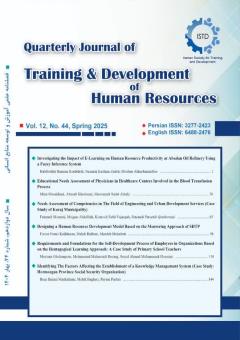طراحی مدل توسعه منابع انسانی مبتنی بر رویکرد منتورینگ (SDTP)
الموضوعات : روش های نوین آموزش وتوسعه منابع انسانیدکتر فیروز نوری كلخوران 1 , مهدی رهبری 2 , مائده محبتی 3
1 - استاديار گروه علوم تربيتي دانشگاه بوعلي سينا
2 - کارشناسی ارشد مدیریت اجرایی، دانشگاه آزاد اسلامی، واحد علوم و تحقیقات، تهران، ایران.
3 - کارشناسی ارشد آموزش و توسعه منابع انسانی، دانشکده روانشناسی و علوم تربیتی، دانشگاه شهید بهشتی، تهران، ایران.
الکلمات المفتاحية: منتورینگ, عناصر مدل منتورینگ, مدل منتورینگ SDTP.,
ملخص المقالة :
کمبود نیروی انسانی متخصص و ضرورت افزایش انگیزه های منابع انسانی با ابزار ارتقاء از داخل موجبات پژوهش حاضر را با رویکرد طراحی منتورینگ فراهم نموده است. رویکرد این پژوهش آمیخته می باشد و در بخش کیفی از روش اکتشافی و در بخش کمی نیز از روش پیمایش استفاده شده است. ابتدا با مصاحبه های تخصصی با متخصصین عناصر مدل منتورینگ استخراج گردید. پس از شناسایی عناصر، در مرحله تعیین عناصر پرسشنامه ای طراحی و توزیع گردید و از طریق سرشماری (کل اعضای جامعه پژوهش) داده ها گردآوری شدند و سپس با دو نیم کردن آزمون اعتبار آزمون از طریق آلفای کرانباخ (%68) تعیین شد. پس از آن از طریق نرم افزار SPSS، آزمون تی تک گروهه نتایج تحلیل شد و همه عناصر شناسایی شده در مرحله قبل مورد تأیید واقع گردید. پس از آن داده ها در قالب جلسه گروه کانونی به صورت یک مدل نهایی تدوین شد. در انجام این فرایند از نرم افزار ISM استفاده شد. عناصر موجود در الگو شامل تهيه پروفايل شناختي منتي، تدوین برنامه توسعه فردی، تعیین حوزههاي عملکردی مهم برای شرکت، شناسایی، ارزیابی و تأمین منتورها، تهیه پروفایل شناختی منتور، تعيين مشاغل کلیدی و تعیین استعدادها، برنامه ریزی توسعه منتورها، ثبت و تنظیم قرارداد یادگیری فیمابین منتی و منتور، اجرای اثربخشی فرآیند منتورینگ برای افراد مختلف، اجرای برنامه منتورینگ، ارزیابی فرآیندی منتورینگ و بهبود آن و ثبت قرارداد مالی منتورینگ با منتور می شود. این مدل موسوم به SDTP در مقاله ارائه شده است.
1. Mulyadi M, Manalu NC, Fadillah AH, Hamta F. Effects of Job Stress, Work Culture and Against the Performance of Lecturers and Work Associations as Intervening Variables at the University of Ibnu Sina. InIAIC International Conference Series 2021 Jan 27 (Vol. 3, No. 2, pp. 83-89).
2. Nwafor S. Training and Development: Strategic Impact on Employees’ Job Performances. African Journal of Management and Business Research. 2022 Jul 31;5(1):50-60.
3. Udai Pareek & Roy P. Lynton (2000), Training for Organisational Transformation, Part-2 Sage Publication, N.D
4. Herr, E. L. (2001). The impact of national policies, economics, and school reform on comprehensive guidance programs. Professional school counseling, 4(4), 236.
5. Hughey, A. W., & Mussnug, K. J. (1997). Designing effective employee training programmes. Training for Quality.
6. Joshi G, Sikdar C. A study of the mentees’ perspective of the informal mentors’ characteristics essential for mentoring success. Global Business Review. 2015 Dec;16(6):963-80.
7. Lord, P., Atkinson, M., & Mitchell, H. (2008). Mentoring and coaching for professionals: A study of the research evidence. Variations, 1(4).
8. McLeod, C. E. H. J., & King, L. A. (1996). Continuing professional development for the information discipline of records management. Part 1: context and initial indications of current activities. Librarian Career Development.
9. Overman, J. P. M., Witte, H. J. L., & Saldarriaga, J. G. (1994). Evaluation of regression models for above-ground biomass determination in Amazon rainforest. Journal of tropical Ecology, 10(2), 207-218.
10. Sanderson, G., & Truelove, S. (1992). Handbook of training and development.
11. Scerri M, Presbury R, Goh E. An application of the mentoring framework to investigate the effectiveness of mentoring programs between industry mentors and student mentees in hospitality. Journal of Hospitality and Tourism Management. 2020 Dec 1;45:143-51.
12. Simkins, T. (2009). Integrating work‐based learning into large scale national leadership development programmes in the UK. Educational review, 61(4), 391-405.
13. Sloman, M. (2005). Learning in knowledge intensive organisations–moving from training to learning. Development and Learning in Organizations: An International Journal.
14. Lumpkin, A. (2011, October). A model for mentoring university faculty. In The educational forum (Vol. 75, No. 4, pp. 357-368). Taylor & Francis Group.
15. Headlam-Wells, J., Gosland, J., & Craig, J. (2006). Beyond the organisation: The design and management of E-mentoring systems. International Journal of Information Management, 26(5), 372-385.
16. Arnesson, K., & Albinsson, G. (2017). Mentorship – a pedagogical method for integration of theory and practice in higher education. Nordic Journal of Studies in Educational Policy, 3(3). https://doi.org/http://dx.doi.org/10.1080/20020317.2017.1379346.
17. Pennanen, M., Bristol, L., Wilkinson, J., & Heikkinen, H. L. T. (2016). What is 'good' mentoring? Understanding mentoring practices of teacher induction through case studies of Finland and Australia. Pedagogy, Culture & Society, 24(1), 27-53.
18. Broughton, R. S., Plaisime, M. V., & Green Parker, M. C. (2019). Mentorship: The necessity of intentionality. American Journal of Orthopsychiatry, 89(3), 317-320. https://doi.org/10.1037/ort0000412
19. Crutcher, R. A., & Howard, C. B. (2018). The importance of mentorships in higher education, Diverse Issues in Higher Education, 35(24), 32-32. https://go.exlibris.link/dmlJXthN
20. Elliott, J. D. (2018). Can a campus-wide faculty mentorship program improve student success? College and University, 93(2), 39-42.
21. Mallette, D., Blatnick-Gagne, K., Alexander, K., Fletcher, J., & Baker, M. (2020). Enhancing self-efficacy for teaching and retention: The need for a career and technical education. Teacher Mentorship Program. 95(5), 28.


